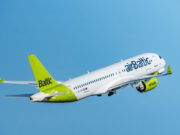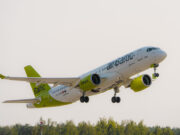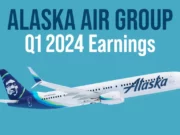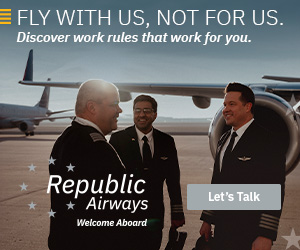 The stability of regional airlines has been brought under scrutiny each time there is a change in the operating relationship between one of the regionals and a mainline carrier. These changes can have a detrimental effect upon the pilots who work for them. They face the potential of losing their jobs, perhaps having to start over with another airline and losing their earned seniority. Understanding the manner in which the regional airlines are organized as businesses could be a factor in how you view them as a potential employer. No business structure is better than another, only different. Each has its strengths and its vulnerabilities.
The stability of regional airlines has been brought under scrutiny each time there is a change in the operating relationship between one of the regionals and a mainline carrier. These changes can have a detrimental effect upon the pilots who work for them. They face the potential of losing their jobs, perhaps having to start over with another airline and losing their earned seniority. Understanding the manner in which the regional airlines are organized as businesses could be a factor in how you view them as a potential employer. No business structure is better than another, only different. Each has its strengths and its vulnerabilities.
There are three different categories of regional airlines: wholly owned, owned by a holdings company, and privately held. The most common in today’s industry is wholly owned, where a major airline like Delta Air Lines or American Airlines owns the regional airline in its entirety. In today’s pilot shortage climate, the wholly owned regional airlines usually receive some sort of financial backing because the major airline cannot afford the wholly owned to fail. A benefit for wholly owned regional airline pilots is usually “flow,” or guaranteed interview. In flow, pilots at the regional airlines have the chance to move up to the major airline that owns their regional. The question is when. It should be noted that while a flow benefits regional airlines when the industry is doing well, flowbacks can occur when the industry is suffering. Flowbacks are an alternative to furloughing for a major airline, resulting in the most junior mainline pilots becoming the most senior regional airline pilots, and thereby posing the potential for the most junior regional airline pilot being furloughed.
While this may all seem peachy, a wholly owned regional does not guarantee that it will be favored by its mainline partner. In the mid-2000s, Delta Air Lines acquired ComAir, making it a wholly owned subsidiary. ComAir, not a large regional airline with high operating cost and only 50-seat jets, was ultimately shut down in 2012 and its routes were distributed among other Delta Connection carriers. American Airlines has three wholly owned regional airlines, some larger than others defined by the size of the pilot group. While operating wholly owned may be preferred, competition still exists among American’s three, and ultimately, business drives how American Airlines determines its regional workload.
The second most common regional airline type is that which is owned by a holdings company. Usually a holding company will own a couple different regional airlines. SkyWest Holdings owns SkyWest Airlines and ExpressJet Airlines. Trans States Holdings owns Trans States, GoJet, and Compass. These holding companies manage their airlines and usually operate as regional carriers for various major airlines. They are most often publically held and traded on the stock market. For the publically traded holding companies, their quarterly and annual investor reports (10-Q and 10-K reports) can be found online, revealing the health of the holding company and each of its associated regional airlines. This information can provide any prospective pilot an idea of the direction the holding company is going. Guaranteed interviews or flows are usually not offered for these regional airlines, but this may slowly be changing with ExpressJet’s program with United Airlines, the Career Pathway Program, a guaranteed interview to all ExpressJet pilots that operate for United Express.
The last type of regional airline is one that is privately held. No investor relation report is found on such airlines. For any privately held company, pilots are letting businessmen and investors determine the course of their careers. If the company does well, pilots have job security. If the company or the industry suffer, their jobs are in jeopardy. This regional airline business model is very difficult to understand because insights into its financial situation is not publicly available. It is possible for a regional airline to be a hybrid of the previous two types – a privately held holdings company, as is the case with Trans States Holdings.
Quicknote: while these are the three different forms of regional airlines, it is possible that a major airline owns a portion of a regional airline without it being a wholly owned airline. For example, United Airlines owns 49% of CommutAir. Republic Airlines, emerging from bankruptcy, will potentially be 60% owned by the three major carriers.
 How are regional airlines awarded flying? Regional airlines will bid for block hours that need to be flown for each month. Factors such as pilot workforce substantially affect how the regional airlines can bid. The major airline will examine various factors to award flying, such as equipment type, cost, and performance factors, (completion percentage being critical) and award flying to the regionals. (Most often, the major airline will incur the cost of fuel for all flying.) Each regional airline then enters into a contract termed a Capacity Purchase Agreement (CPA) with each major airline. The contract stipulates how long the regional airline will support the major airline. Just as with any contract, the details are critical and provisions are limited to terminate the contract early.
How are regional airlines awarded flying? Regional airlines will bid for block hours that need to be flown for each month. Factors such as pilot workforce substantially affect how the regional airlines can bid. The major airline will examine various factors to award flying, such as equipment type, cost, and performance factors, (completion percentage being critical) and award flying to the regionals. (Most often, the major airline will incur the cost of fuel for all flying.) Each regional airline then enters into a contract termed a Capacity Purchase Agreement (CPA) with each major airline. The contract stipulates how long the regional airline will support the major airline. Just as with any contract, the details are critical and provisions are limited to terminate the contract early.
Why is this important for any new pilot entering into the regional airline industry? In today’s pilot shortage world, it may not mean much. Wholly owned regional airlines that perform well will continue to obtain more flying and regional airlines that cannot attract pilots and perform poorly will lose flying. A flow or guaranteed interview is a major factor for pilots choosing a regional airline, but because flow follows seniority order, it may be quicker for a new pilot to be hired from outside the flow. It is then noteworthy to end with this statement: The airline industry has proven to be identifiably cyclical. While we are now in the midst of a huge hiring spree in the aviation industry, at levels not seen in decades, there may be a point at which it halts or reverses course.























































